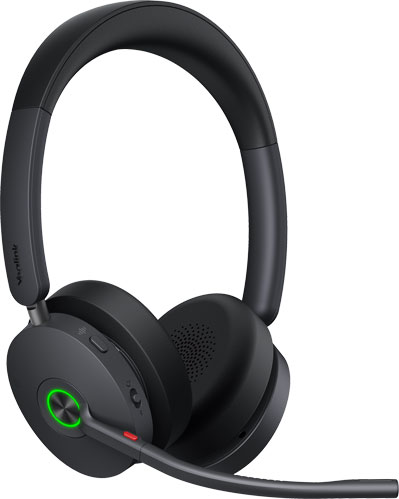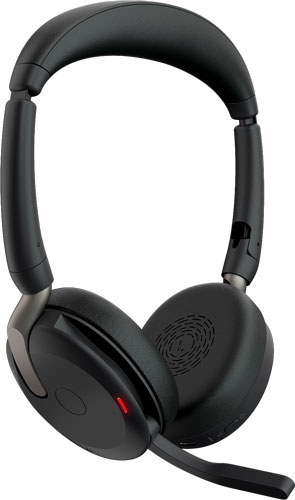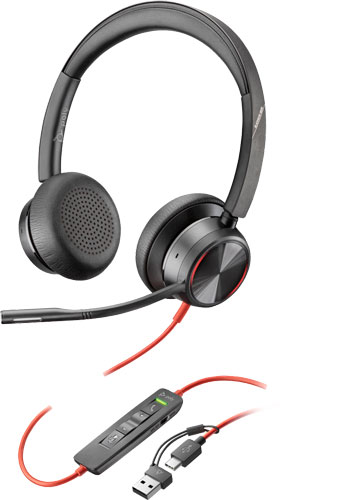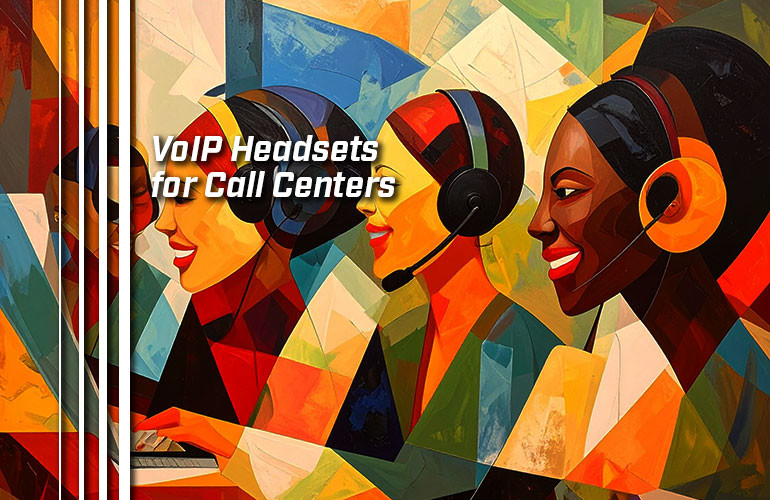Call centers and contact centers are some of the most demanding environments for headsets.
All-day comfort. Long-lasting durability. Audio performance. Ease of use. Manageability in the system.
They keep workers’ hands free while letting them talk with customers and clients.
There are a lot of things to think about when shopping for VoIP headsets for contact centers.
In our world of AI chatbots, call centers with actual humans on the phone are a positive point of differentiation.
Differentiate your business even more by improving audio quality with a professional headset for call centers.
And improve worker happiness by giving everyone the best tool for their job.
Call centers aren’t simply rows of people in the office anymore. With the rise in distant work, home office call center workers and hybrid call center workers are common now.
People taking calls at home require professional audio, too.
That adds another wrinkle when shopping for contact center VoIP headsets.
If you’d like to know more about headsets in general, check out our clear, detailed, and up-to-date Headsets Buyer’s Guide.
In this blog, we provide an in-depth look at call center headsets.
Let’s get into it!

Features to Look for in Call Center Headsets
What is a call center headset? It’s simply a headset that’s used in a call center. It demands a balance between many features.
What features to look for is determined by location, budget, and personal preference.
When you picture a call center in your mind, you probably think of row after row of call agents sitting at computers.
These types of contact centers are still very much part of the business world.
But call centers can also be dispersed groups of people who work from home.
Hybrid workers spend some days at home, some days at work — an arrangement that many workers nowadays really appreciate. Using hybrid work arrangements is a differentiating factor in the job market.
The locations — onsite and home — demand headsets with different features.
Office headsets for call centers need noise cancellation, both for what the wearer hears and what they transmit. We cover noise cancellation, including Active Noise Cancellation, below. You might want headsets with busylights to reduce distractions in the office. If you use wireless headsets, you might want a mixture of Bluetooth and DECT headsets to reduce spectrum density.
Home office headsets for call centers can be simpler. Simple connectivity is key, because workers need to set them up themselves. Noise cancellation isn’t as big of a deal, unless there are children or pets to consider.
Hybrid workers need headsets that combine the best of both types — and can withstand travel.
We’ll get into it.
As far as budget is concerned, our only recommendation is to make sure you buy headsets that actually cover all the bases. If you skimp on your initial purchase, you could end up having to shell out for a whole bunch of replacements sooner rather than later.
In terms of business communications devices, headsets can be one of the longest lasting. It’s not unusual for them to last a decade or more, so a slightly bigger initial investment can lead to improved ROI.
Audio quality can be a major differentiator when it comes to customer service and client acquisition. Get a sketchy sounding call? You’re gonna hang up.
Providing premium, professional tools for workers — especially younger workers, who are more demanding — also can be a differentiator for your business.
Let’s get into the features!
- Durability & Comfort
- Audio Quality & Noise Cancellation
- Call Controls
- Busylight
- Sidetone
- Headset Management Software
After the features, we talk about Wired Call Center Headsets vs Wireless Call Center Headsets.

Durability & Comfort
One of the most important features of a call center headset is durability. You’ll find reliable durability by shopping for proven brands.
Here at IP Phone Warehouse, we only work with business-class headset manufacturers and sell authentic products with a proven logistics and distribution chain. Knock-offs and counterfeits are sold by many online retailers — never by us.
Professional headsets are built for durability, and we only sell professional headsets. So, this feature of a call center headset is actually easy to find!
Comfort is a different question. If an agent is talking all day, they need all-day comfort.
Headset comfort is created by two things in particular: ergonomic design and padding.
Many headset manufacturers have invested in headset ergonomics. For example, Jabra has gotten biometric measurements from hundreds of people’s heads that they’ve use to improve how the headset fits.
One example of these improvements is angled earcups that sit on the ear better. Another is using lighter weight materials.
Look for the headsets that emphasize ergonomic design to improve comfort.
Headset padding is another way to improve comfort. Gone are the days of earphones covered in cheap black sponges. Now, headset manufacturers offer premium materials.
Let’s use Jabra as an example again. Headsets like the Jabra Evolve2 75 uses dual-foam technology with hard foam on the outside and soft foam on the inside, all covered with soft leatherette with a design tailored for ventilation. All. Day. Comfort.
Audio Quality & Noise Cancellation
Headsets improve audio quality over standard VoIP phone handsets.
By improving audio quality, you differentiate your business from others who don’t have professional sound.
They not only put the microphone near your mouth. Many feature noise cancelling and audio enhancing technologies.
Noise cancellation is vitally important for call center headsets when there are lots of workers in the same place.
Active Noise Cancellation (ANC) is when a headset interprets ambient noise and produces counter-sound in the headset to cancel out the ambient noise. The effect of counter-sound is, strangely, silence. It’s kind of like audio camouflage.
ANC is one of the most desired features by workers. It helps people focus by blocking out distractions.
It’s particularly important in busy locations with lots of background noise. A busy call center is chaotic. Helping call agents focus and hear conversations better can be a major boon to your business.
If you’d like to know more about ANC, check out our blog, “Active Noise Cancellation vs Passive Noise Cancellation.”
It’s also not the only form of noise cancellation you should know about.
Active Noise Cancellation doesn’t refer to a technology cancelling out the noise that a headset transmits. It refers to cancelling out noise that the wearer hears.
There are many forms of noise cancellation that deals with transmitted noise. One common version goes by a number of names depending on company branding. Yealink Headsets feature Acoustic Shield, so let’s use that an example. Yealink BH74 features Acoustic Shield 3.0 — they’ve gotten good at this.
Acoustic Shield works by having additional microphones to the mics that pick up your voice. These extra mics pick up surrounding noise. Based on the differences in sound pressure, headset determines how far away sounds are coming from. The headset can then simply eliminate sounds originating beyond a distance that you select. It’s basically like setting up a virtual wall to block out noise.
Transmitting less background noise improves comprehension and makes your business sound more professional.
There are also concerns simply with component quality. Are the speakers professional grade? The microphones? As with durability, going with call center headsets from proven manufacturers ensure that you’re not paying for something too good to be true, that you’ll end up regretting because the sound is so bad.
The headsets we sell are all professional grade.

Call Controls
Call center agents need to answer calls promptly and with a minimum of fuss. Which type of call control you should go with is dependent on personal preference.
With headsets, there are two types of call controls integrated with a headset: on the headset or inline. There are also headsets with no call controls at all.
Basic headsets have no call controls built into them, so you have to answer on the phone or on the computer, if you’re using a softphone. (You might have to use a handset lifter in some cases.) These can save on costs and, for many users, offer a familiar method of answering a call.
Call controls built into the headset itself are found on many consumer Bluetooth headphones now. You tap a button to answer or end a call. While they can be convenient, some workers don’t like needing to press a button they can’t see. This type of call control can be found in both wired headsets and wireless headsets.
Inline call controls are built into a wired USB headset’s cable. In the middle of the cable that you plug into your VoIP phone or computer, there will be a small unit that has buttons for call answer/end and so on. Inline call controls are convenient and let the agent see what button they’re pressing.
Busylight
For onsite headsets, a busylight or on-call indicator light can be a real boon.
A busylight is simply a light on a headset that shows your status: red for busy, green for available, and so on.
They’re a simple feature, but one that’s quite popular with workers, because they cut down on distractions.
Is Kevin free to talk? Sarah looks across the room. He’s sitting at his desk, not talking, so maybe he’s free? She sees that his headset is showing a red light, so she knows he’s on a call.
That’s how a busylight works. Very convenient for call centers!
Sidetone
If you have workers wearing stereo headsets, you should know about sidetone.
Sidetone refers to the audio being picked up by a headset’s microphone being instantly played back in the headset’s speakers.
Why is sidetone important? When you wear a stereo headset, both of your ears are covered, which makes it hard to hear yourself speak — especially if you have noise cancellation on.
With sidetone on, you can hear yourself talk better when your ears are covered, which lets you speak in a more natural tone. It’s particularly nice for stereo headsets, but it’s even nice for mono or one-ear headsets.
How do you activate sidetone? Sidetone will probably be controlled in the headset’s application. You should be able to activate it and select how loud you want it to be.
Sidetone can be a bit jarring when you first turn it on, because you’re hearing your own voice in a new way, but you’ll quickly adapt to it. And once you’ve adapted to it, you’ll wonder how you ever lived without it.
We wrote a blog on sidetone with phone handsets that covers the concept in more detail, if you’re interested.
Headset Management Software
This topic isn’t specifically about the headset themselves, but we thought it was worth a mention.
Call center headsets can be managed centrally. Applications like Jabra Xpress let you keep track of inventory, see how they’re being used to help workers be more productive and improve inventory efficiency, upgrade firmware across a whole fleet at the same time, and more.
Even better, because the headsets only need to be connected to the central system via the internet, you can actually manage the headsets in the office and in remote locations, including home workers and hybrid workers, all at the same time.
If this sounds desirable to you, it’s really worthwhile to ensure that your call center headsets are compatible with a headset management application that suits your needs.

Wired VoIP Headsets vs Wireless VoIP Headsets for Call Centers
Headsets come in two varieties: wired and wireless. Both are used in call centers.
What are the advantages of wired VoIP headsets? What are the advantages of wireless VoIP headsets?
Wired Call Center Headsets
Wired Headsets are less expensive than their wireless equivalents, which makes them attractive as call center headsets. They can also be more reliable, because wired devices are still more reliable than wireless devices.
Wired call center headsets come in two varieties: RJ9 and USB.
RJ9 headsets are the traditional wired headsets that use the same plug as an old telephone plug. They can be reliable and inexpensive but can also require accessories like a headset lifter or EHS cable for full functionality. Their audio quality isn’t as good as more modern models. They also can only be used with one device: a desk phone.
USB Headsets are wired headsets that plug into a USB port on either a VoIP phone or computer. Some USB-C headsets can also be used with smartphones and tablets, too.
You’ll find USB headsets for both USB types: USB-A and USB-C. Many USB headsets now come with a USB-C cable with an attached USB-A adapter, so you can use them with either port type out of the box.
USB headsets are plug-and-play, versatile, budget friendly, and can offer premium audio quality. Wired devices are still more reliable than wireless devices. And they might come with an inline call control unit.
(A word of caution: just because a VoIP phone has a USB port, doesn’t mean that it supports USB headsets. Always check the datasheet before purchase. It’ll tell you if the USB port supports headsets.)
Wireless Call Center Headsets
Wireless Headsets are desirable for many workers because they’re more convenient.
They come in two varieties: DECT and Bluetooth. For a comprehensive review of the two types of cordless VoIP headsets, check out our recent blog, “Wireless Headsets for VoIP Compared: Bluetooth vs DECT.”
tl;dr — DECT headsets have a longer wireless range but require a base station or DECT adapter to connect to any device. Bluetooth headsets are more versatile and only require a Bluetooth adapter to connect to a computer.
Both types are more expensive than their wired equivalents, but on average workers prefer wireless headsets. Smartphones don’t have 3.5 mm jacks anymore and young people probably don’t know what an Ethernet port even is used for. People are used to wireless.
If you’re going with wireless headsets, make sure that they have all-day battery life. And make sure you’re looking at talk time.
For example, Yealink BH74 offers up to 32 hours of talk time, but that’s without Active Noise Cancellation or the busylight on. The same headset offers up to 65 hours of music listening time with ANC off. So talk time vs listen time can be very different, and some features — especially ANC — can use a lot of juice.
Still, BH74 offers more than enough battery life for a full day of work! Even with the caveats, 32 hours of battery life for talking is about as much as you’ll ever see, especially when you take into consideration its amazing audio quality and professional, ergonomic design.
One last thing! (Thanks for sticking with us.)
If your business uses a lot of wireless headsets, then you should know about the effects of spectrum density on communications.
Wireless technologies like Wi-Fi, Bluetooth, and DECT use specific slices of the wireless spectrum.
Bluetooth devices, for example, communicate over the same slice of the wireless spectrum. If there are too many Bluetooth devices, they compete for room. If there isn’t enough room, the effect is a drop in audio quality, signal loss, and so on.
But if you use different types of wireless devices, they use different slices of the spectrum.
So, if you want to use wireless call center headsets and there are a lot of workers in a relatively small space, you should consider having some workers use Bluetooth headsets and other workers use DECT headsets.
The two types of headsets use different slices of the wireless spectrum, so they don’t compete with each other. Thus, spectrum density is mitigated, and you get a better signal.

